|
We are overdue for a holiday away from "Riverbend" but it is difficult to
travel with our dogs so we have decided on two separate trips: I will go up to
North Queensland for two weeks in late April/early May and Padma will visit her parents
in Surabaya for five weeks in May/June.
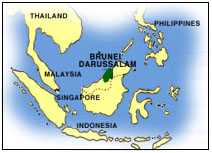 Padma flies on "Royal Brunei"
from Sydney to
Bandar Seri Begawan, the capital of Brunei, and from there to her hometown
Surabaya in East Java.
Padma flies on "Royal Brunei"
from Sydney to
Bandar Seri Begawan, the capital of Brunei, and from there to her hometown
Surabaya in East Java.
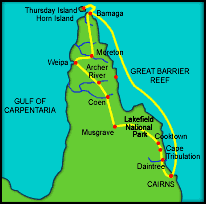 My own trip to North Queensland has a twofold purpose: I want
to inspect another property that's currently for sale at
Kuranda in the mountains inland
from Cairns, and I want to take a trip up to Thursday Island by boat. I found out about this
trip when I was in Cairns in
November 2003 but it was too late then to make the necessary arrangements. I lived
and worked on Thursday Island in 1977 and have always wanted to go back so here is my chance
to see it again at least for the day while the ship on which I have booked, the
"Trinity Bay" stops there. I expect it to be an emotional, even tearful return for me
as many happy memories are tied up with my short few months on Thursday Island
before this run-away train called life took me away on a white-knuckled ride through
half-a-dozen more countries and some twenty-or-more work assignments until finally retirement
caught up with me here at "Riverbend."
I have written postcards to Lance and Millie Fulwood, "Canadian Jim", "Roly" Kirk of the Rainbow Motel and the ex-skipper
of the MV TSI, Brian Pearson, as I hope to have a beer with them but so far, alas, no
reply yet.
My own trip to North Queensland has a twofold purpose: I want
to inspect another property that's currently for sale at
Kuranda in the mountains inland
from Cairns, and I want to take a trip up to Thursday Island by boat. I found out about this
trip when I was in Cairns in
November 2003 but it was too late then to make the necessary arrangements. I lived
and worked on Thursday Island in 1977 and have always wanted to go back so here is my chance
to see it again at least for the day while the ship on which I have booked, the
"Trinity Bay" stops there. I expect it to be an emotional, even tearful return for me
as many happy memories are tied up with my short few months on Thursday Island
before this run-away train called life took me away on a white-knuckled ride through
half-a-dozen more countries and some twenty-or-more work assignments until finally retirement
caught up with me here at "Riverbend."
I have written postcards to Lance and Millie Fulwood, "Canadian Jim", "Roly" Kirk of the Rainbow Motel and the ex-skipper
of the MV TSI, Brian Pearson, as I hope to have a beer with them but so far, alas, no
reply yet.
 [P.S. I have since been able to make email contact with a very nice lady by the name of Nola
who works for the Council on TI. She knows the people I have known and
tells me that the Fulwoods now live in Mackay and Roly in Cairns, "Canadian Jim" is now in his
80s and lives on Horn Island ("Canadian Jim" liked his drink and it wasn't
"Canada Dry" and I am surprised his liver held out this long -
his "shadow" Ron Taylor retired from IIB in 2001 and moved to Cairns where
passed away in 2003),
and Brian Pearson (who "inherited" my dog Snoopy when I left the island) and his wife Sara still live on TI where
he drives a taxi. Brian, you've got yourself a fare for Sunday the 24th of April!
- maybe even longer as I am seriously considering staying over on the island
and taking the same boat back when it returns a week later. Nola also mentioned that
David Richardson's shack at Country Women's Beach on Prince-of-Wales Island was bought
by her brother many years ago, that the huge cyclone-proof shed which Yvonne, the hairdresser,
and her husband built at Bluefish Point was later moved to the main beach now called
Muralug and that somebody else, "Maori George", now lives in it,
[P.S. I have since been able to make email contact with a very nice lady by the name of Nola
who works for the Council on TI. She knows the people I have known and
tells me that the Fulwoods now live in Mackay and Roly in Cairns, "Canadian Jim" is now in his
80s and lives on Horn Island ("Canadian Jim" liked his drink and it wasn't
"Canada Dry" and I am surprised his liver held out this long -
his "shadow" Ron Taylor retired from IIB in 2001 and moved to Cairns where
passed away in 2003),
and Brian Pearson (who "inherited" my dog Snoopy when I left the island) and his wife Sara still live on TI where
he drives a taxi. Brian, you've got yourself a fare for Sunday the 24th of April!
- maybe even longer as I am seriously considering staying over on the island
and taking the same boat back when it returns a week later. Nola also mentioned that
David Richardson's shack at Country Women's Beach on Prince-of-Wales Island was bought
by her brother many years ago, that the huge cyclone-proof shed which Yvonne, the hairdresser,
and her husband built at Bluefish Point was later moved to the main beach now called
Muralug and that somebody else, "Maori George", now lives in it,
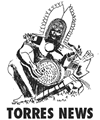 and that
Gwen Maloney, the publisher of the "TORRES NEWS", the island's weekly newspaper
(or, as we called it, the 'Birthday Book' as it dealt mainly with people's personal affairs),
passed away last year. She had sold the "Torres News" some fifteen years ago to another lady who in turn
resold it to Mark Bousen two-and-a-half years ago. Mark tells me that I won't recognise
the newspaper anymore which is now a full-colour, weekly tabloid publication with a
circulation of 3000.
So, as Nola puts it, nothing stays the same forever, not even on TI, except perhaps the
island's main street which still "is a ghost town on a Sunday."]
and that
Gwen Maloney, the publisher of the "TORRES NEWS", the island's weekly newspaper
(or, as we called it, the 'Birthday Book' as it dealt mainly with people's personal affairs),
passed away last year. She had sold the "Torres News" some fifteen years ago to another lady who in turn
resold it to Mark Bousen two-and-a-half years ago. Mark tells me that I won't recognise
the newspaper anymore which is now a full-colour, weekly tabloid publication with a
circulation of 3000.
So, as Nola puts it, nothing stays the same forever, not even on TI, except perhaps the
island's main street which still "is a ghost town on a Sunday."]
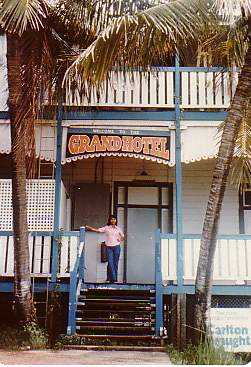 Some things will have changed on
Old T.I.:
for instance, the Grand Hotel - renowned as "the pub where Somerset Maugham stayed",
burnt down in 1993. The Grand was famed in the Torres Strait as a watering
hole and resting place for pearlers, fishermen and travelling sales representatives. Maugham
slept and wrote at the rambling 102-year-old hotel at least once, in 1921, when he complained
about its kitchen's tendency to produce turtle soup "so often that I have ceased to look
upon it as a luxury". The British author described his arrival at the hotel in
'French Joe', a short
story he apparently wrote - along with another,
'German Harry' -
while staying at the Grand.
(If I were a writing man, I could add my own stories about
Cec Burgess and "Canadian Jim", to name just two.)
Of course, back in 1977
I still had my head firmly buried in accountancy text books and had neither heard of Somerset Maugham
nor read his stories which makes this trip almost thirty years later all the more poignant.
Some things will have changed on
Old T.I.:
for instance, the Grand Hotel - renowned as "the pub where Somerset Maugham stayed",
burnt down in 1993. The Grand was famed in the Torres Strait as a watering
hole and resting place for pearlers, fishermen and travelling sales representatives. Maugham
slept and wrote at the rambling 102-year-old hotel at least once, in 1921, when he complained
about its kitchen's tendency to produce turtle soup "so often that I have ceased to look
upon it as a luxury". The British author described his arrival at the hotel in
'French Joe', a short
story he apparently wrote - along with another,
'German Harry' -
while staying at the Grand.
(If I were a writing man, I could add my own stories about
Cec Burgess and "Canadian Jim", to name just two.)
Of course, back in 1977
I still had my head firmly buried in accountancy text books and had neither heard of Somerset Maugham
nor read his stories which makes this trip almost thirty years later all the more poignant.
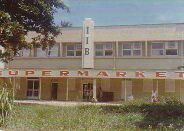 When I lived and worked on the island,
the Grand's dining room had been crammed with souvenirs
When I lived and worked on the island,
the Grand's dining room had been crammed with souvenirs
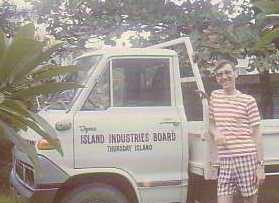 of the Torres Strait's maritime history,
but early on the 5th of March, 1993
all was destroyed in a blaze which began about 4am and
swept through the timber building in less than an hour, forcing the evacuation of 12 people
and causing about $2 million damage. No one was injured but together with the then licensee,
Mr Norm Shadbolt, the whole island mourned the enormous loss of history.
of the Torres Strait's maritime history,
but early on the 5th of March, 1993
all was destroyed in a blaze which began about 4am and
swept through the timber building in less than an hour, forcing the evacuation of 12 people
and causing about $2 million damage. No one was injured but together with the then licensee,
Mr Norm Shadbolt, the whole island mourned the enormous loss of history.
Thursday Island - also known as the "Thirsty Island" - has always been well
endowed with hotels and its lusty frontier town atmosphere has meant they have usually
done well. Apart from the Grand Hotel, the
Federal,
Torres, Royal, Imperial, and Metropole
have been witness to much that characterises boom economic growth. However, the
Imperial and the Metropole no longer exist.
T.I. has also seen the intrepid yachtsman Joshua Slocum, the famous German warship the
"Emden," Tarzan of the North Michael Fomenko and more recently the Danish
adventurer Hans Tholstrup.
Magical powers of a local tree are also claimed. The Wongai is a native tree of the
Torres Strait bearing a small fruit similar to a plum which is eaten ripe or dried.
The seed is used in Island jewellery and the timber is excellent for woodcarving.
Perhaps the most famous Wongai on T.I. was one located in front of the Federal Hotel
which was planted about 1900 and blown over by cyclone "Otto" in February
1977. The local legend claims that if you eat the fruit of the Wongai you are destined
to return.
T.I. has witnessed many changes in its
history but perhaps the greatest influence
has come from the discovery of pearl shell in the 1860s. This industry provided employment
for many islanders and was responsible for the influx of foreigners to T.I. especially
the Japanese. Pearl shelling boomed until the immediate post-war years when the industry
entered a depressed state. Australian and Japanese interests established several cultured
pearl farms in the early 1960s and pearling has continued in this form until the present
day. At my time on T.I., the Island Industries Board still maintained a pearl store on
Victoria Parade and shipped out a small amount of pearl shell. Tom Fujii, the last of the
Japanese deep-sea pearl divers, was still alive then and an article headlined,
"Fujii, last of the men
who dived with death", appeared on 31st March 1977 in "The Australian" in memory of Tom
and the other 6000-odd young Japanese imported into the Torres Strait between the 1870s and 1940.
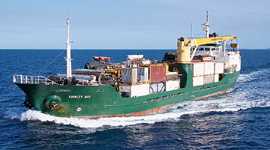 I'll be boarding the MV "Trinity Bay" at Cairns on Friday, the 22nd of April.
The ship is approximately 80m long and carries an average of 35 passengers on its important journey to
Thursday Island and Cape York each week. The vessel carries approximately 3500 tonnes of cargo and travels up
to 13.5 knots.
The ship departs every Friday afternoon and travels north towards her most northern destination, Thursday Island,
arriving there on Sunday. The coastline is in sight most of the way except when it crosses Princess Charlotte Bay
just south of Lockhart River.
I'll be boarding the MV "Trinity Bay" at Cairns on Friday, the 22nd of April.
The ship is approximately 80m long and carries an average of 35 passengers on its important journey to
Thursday Island and Cape York each week. The vessel carries approximately 3500 tonnes of cargo and travels up
to 13.5 knots.
The ship departs every Friday afternoon and travels north towards her most northern destination, Thursday Island,
arriving there on Sunday. The coastline is in sight most of the way except when it crosses Princess Charlotte Bay
just south of Lockhart River.
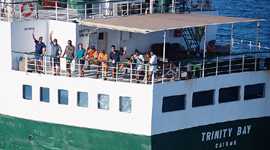 After leaving Cairns it’s not long until the ship reaches
Double Island.
On this island there is a resort which was developed
by Robert and Janet Holmes-A’court. Next is Port Douglas and Low Isles,
where the first course change occurs after leaving the
Cairns channel. The ship then travel on to
Cape Tribulation, Hope Islands,
Gubbins Reef and Cooktown where Captain
Cook repaired the “Endeavour”. He entered Cooktown on the 17th June 1770 and
departed on the 4th August 1770.
As the ship heads north it passes Cape Flattery, the loading port for a silica
sand mining operation, and
Lizard Island
with its well-known upmarket resort.
After leaving Cairns it’s not long until the ship reaches
Double Island.
On this island there is a resort which was developed
by Robert and Janet Holmes-A’court. Next is Port Douglas and Low Isles,
where the first course change occurs after leaving the
Cairns channel. The ship then travel on to
Cape Tribulation, Hope Islands,
Gubbins Reef and Cooktown where Captain
Cook repaired the “Endeavour”. He entered Cooktown on the 17th June 1770 and
departed on the 4th August 1770.
As the ship heads north it passes Cape Flattery, the loading port for a silica
sand mining operation, and
Lizard Island
with its well-known upmarket resort.
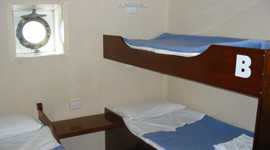 Early Saturday morning the ship arrives at Cape Melville, the southern point of
Princess Charlotte Bay and the site of one of
Queenslands worst maritime disasters, when on the 4th and 5th March 1899 a
cyclone passed over the area. It destroyed
the pearling fleet with the loss of 307 lives, 5 large vessels and 54 luggers.
The cyclone was named Mahina, had a
central pressure of 914mb and produced a storm surge of over 40 feet.
Cape Melville is part of the Melville National
park famous for its foxtail palms which were unique to the area and
much sought after by horticulturists. This demand
encouraged poachers who, each year when the palms seeded, mounted a
harvesting program which produced an equal
effort by the park rangers to apprehend the poachers. The poachers must
have been successful as these palms can now
be purchased in most nurseries.
Early Saturday morning the ship arrives at Cape Melville, the southern point of
Princess Charlotte Bay and the site of one of
Queenslands worst maritime disasters, when on the 4th and 5th March 1899 a
cyclone passed over the area. It destroyed
the pearling fleet with the loss of 307 lives, 5 large vessels and 54 luggers.
The cyclone was named Mahina, had a
central pressure of 914mb and produced a storm surge of over 40 feet.
Cape Melville is part of the Melville National
park famous for its foxtail palms which were unique to the area and
much sought after by horticulturists. This demand
encouraged poachers who, each year when the palms seeded, mounted a
harvesting program which produced an equal
effort by the park rangers to apprehend the poachers. The poachers must
have been successful as these palms can now
be purchased in most nurseries.
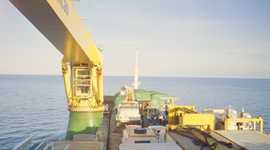 Pipon Island is the point where the vessel deviates from the regular shipping
channel and transits the Fairway Channel
taking it between the Inner and Outer reef. At times the large ocean swells can be
seen breaking on the outer reef.
Not long after departing Pipon Island, the Flinders group of islands can be
seen on the portside of the vessel. These
islands are sacred areas to the local Aborigines and also posses some very
impressive galleries of rock paintings.
Pipon Island is the point where the vessel deviates from the regular shipping
channel and transits the Fairway Channel
taking it between the Inner and Outer reef. At times the large ocean swells can be
seen breaking on the outer reef.
Not long after departing Pipon Island, the Flinders group of islands can be
seen on the portside of the vessel. These
islands are sacred areas to the local Aborigines and also posses some very
impressive galleries of rock paintings.
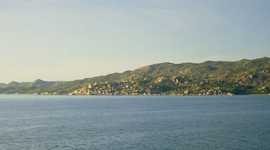 As the vessel travels through an outer passage north of the Flinders group,
numerous sand cays and reef outcrops become
visible in close proximity. During the fishing season, a number of trawlers
can also be seen in these grounds.
As the vessel travels through an outer passage north of the Flinders group,
numerous sand cays and reef outcrops become
visible in close proximity. During the fishing season, a number of trawlers
can also be seen in these grounds.
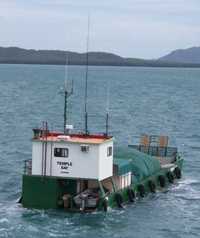 On Saturday afternoon the "Trinity Bay" arrives at Lockhart River, the
first stop on the northern voyage. Here it meets another Sea
Swift vessel the "Temple Bay" to which it tranships cargo destined for the
Lockhart River community. The "Temple Bay" is a 23 metre
landing barge which is used to carry the cargo to shore as there is only a
barge ramp in this area and the surrounding shallow
area prohibits access to the "Trinity Bay".
On Saturday afternoon the "Trinity Bay" arrives at Lockhart River, the
first stop on the northern voyage. Here it meets another Sea
Swift vessel the "Temple Bay" to which it tranships cargo destined for the
Lockhart River community. The "Temple Bay" is a 23 metre
landing barge which is used to carry the cargo to shore as there is only a
barge ramp in this area and the surrounding shallow
area prohibits access to the "Trinity Bay".
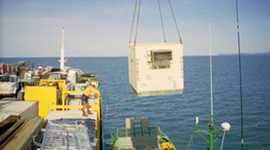 After leaving the anchorage at Lloyd Bay the ship passes Restoration Island,
which is significant as the first landfall of Captain
William Bligh after he and his companions were forced into the long boat during
the mutiny of the “Bounty” near Tahiti.
A few miles further on is Portland Roads which until the 1980's used to have a
large timber wharf used by the allies during
World War 2 as a jump off point for the New Guinea campaign. The wharf was more
recently blown up by the Navy
because of its dilapidated condition. Portland Roads is a safe anchorage used by
the fishing fleet and the motherships
which supply them with fuel, water and stores, and unload their catch which is
returned to Cairns for export.
The community ashore attracts people who tend to follow an alternative lifestyle,
avoiding the pressures of city dwellers.
Three hours further north the ship passes Cape Grenville and the Home Island group,
most of which were named by Captain
Cook after members of the “Endeavour” crew. Occasionally the "Trinity Bay"
stops at this location to deliver cargo to a couple of the
small resort islands.
After leaving the anchorage at Lloyd Bay the ship passes Restoration Island,
which is significant as the first landfall of Captain
William Bligh after he and his companions were forced into the long boat during
the mutiny of the “Bounty” near Tahiti.
A few miles further on is Portland Roads which until the 1980's used to have a
large timber wharf used by the allies during
World War 2 as a jump off point for the New Guinea campaign. The wharf was more
recently blown up by the Navy
because of its dilapidated condition. Portland Roads is a safe anchorage used by
the fishing fleet and the motherships
which supply them with fuel, water and stores, and unload their catch which is
returned to Cairns for export.
The community ashore attracts people who tend to follow an alternative lifestyle,
avoiding the pressures of city dwellers.
Three hours further north the ship passes Cape Grenville and the Home Island group,
most of which were named by Captain
Cook after members of the “Endeavour” crew. Occasionally the "Trinity Bay"
stops at this location to deliver cargo to a couple of the
small resort islands.
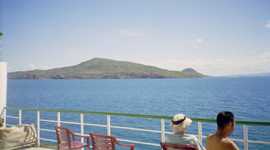 As always there are small islands and reefs that the ship passes on its way north.
Some of these islands and sand cays
are popular turtle breeding grounds for turtles from all around the world.
Every summer they converge here to lay
eggs and breed. Each year in December we transport officers from the
Department of Environment and Heritage to
Milman Island to carry out research and gather information about the turtles,
which goes towards a better understanding
of their habits and needs and in turn helps to protect the species.
As always there are small islands and reefs that the ship passes on its way north.
Some of these islands and sand cays
are popular turtle breeding grounds for turtles from all around the world.
Every summer they converge here to lay
eggs and breed. Each year in December we transport officers from the
Department of Environment and Heritage to
Milman Island to carry out research and gather information about the turtles,
which goes towards a better understanding
of their habits and needs and in turn helps to protect the species.
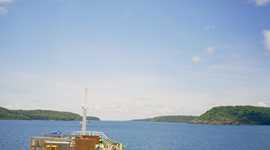 Early Sunday morning finds the ship close to Cape York and Albany Island.
In the Albany Passage (an optional route
sometimes taken by the ship) is one of the many pearl farms in the Torres
Strait area and also the remains of the
ill-fated community of Somerset, the once mooted "Singapore of the Pacific", and the
Jardine family
residence. Just off Albany Island lies the wreck of the
“Quetta”,
a passenger ship that sank in 1890. The ship hit an uncharted rock and
sank in a very short time resulting in the loss of
133 lives. Some relics from the “Quetta” can be seen in the Anglican
Church on Thursday Island.
Early Sunday morning finds the ship close to Cape York and Albany Island.
In the Albany Passage (an optional route
sometimes taken by the ship) is one of the many pearl farms in the Torres
Strait area and also the remains of the
ill-fated community of Somerset, the once mooted "Singapore of the Pacific", and the
Jardine family
residence. Just off Albany Island lies the wreck of the
“Quetta”,
a passenger ship that sank in 1890. The ship hit an uncharted rock and
sank in a very short time resulting in the loss of
133 lives. Some relics from the “Quetta” can be seen in the Anglican
Church on Thursday Island.
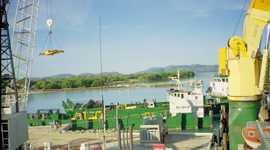 Sunday morning is spent at
Horn Island.
Here passengers are given the opportunity to
learn about an often forgotten
part of history – the role of Horn Island and the Torres Strait in the Second World War.
A local tour is available
with an expert guide, who is the curator/owner of the local museum. Some of the
sites visited include two World
War II plane relics, slit trenches, taxi ways, a 3.7 inch gun site, an
underground command post, and the Torres
Strait Heritage Museum. As well as the historic aspect, the tour also takes
in scenic sites of Horn Island. Only
passengers taking part in the tour are allowed to disembark at Horn Island.
Sunday morning is spent at
Horn Island.
Here passengers are given the opportunity to
learn about an often forgotten
part of history – the role of Horn Island and the Torres Strait in the Second World War.
A local tour is available
with an expert guide, who is the curator/owner of the local museum. Some of the
sites visited include two World
War II plane relics, slit trenches, taxi ways, a 3.7 inch gun site, an
underground command post, and the Torres
Strait Heritage Museum. As well as the historic aspect, the tour also takes
in scenic sites of Horn Island. Only
passengers taking part in the tour are allowed to disembark at Horn Island.
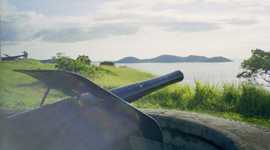 Finally, on Sunday afternoon the "Trinity Bay " arrives at
Thursday Island (TI).
TI was settled in 1877 when it was decided to re-locate the
government administration point from Somerset to a more suitable spot.
The island was chosen for its closeness
to the main shipping channel and it’s well sheltered port.
The hunt for pearl-shell, bêche-de-mer and trochus
attracted many people from around the world to these shores and
a number of whom decided to stay and adopt the island as their home.
Finally, on Sunday afternoon the "Trinity Bay " arrives at
Thursday Island (TI).
TI was settled in 1877 when it was decided to re-locate the
government administration point from Somerset to a more suitable spot.
The island was chosen for its closeness
to the main shipping channel and it’s well sheltered port.
The hunt for pearl-shell, bêche-de-mer and trochus
attracted many people from around the world to these shores and
a number of whom decided to stay and adopt the island as their home.
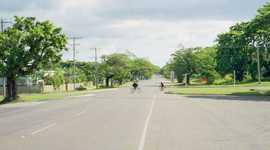 Arrangements can be made for a personalised and informative bus tour of the Island
by a local guide who will show
you why TI is one of the most culturally and historically interesting places in Australia.
The tour takes in spectacular
views and visits the Torres Strait Museum (not always accessible on Sundays),
Green Hill Fort (circa 1891), Quetta
Memorial Cathedral and the Japanese Pearl Divers Memorial at the local cemetery.
Arrangements can be made for a personalised and informative bus tour of the Island
by a local guide who will show
you why TI is one of the most culturally and historically interesting places in Australia.
The tour takes in spectacular
views and visits the Torres Strait Museum (not always accessible on Sundays),
Green Hill Fort (circa 1891), Quetta
Memorial Cathedral and the Japanese Pearl Divers Memorial at the local cemetery.
On Monday the vessel travels back to the mainland of Australia to the jetty at Seisia,
one of the communities in the
Bamaga area, for approximately five to six hours. The jetty at Seisia is the only
jetty at the top, and lays claim to be
“Australia’s Best Fishing Jetty”.
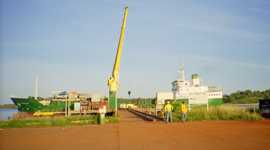 Seisia is the coastal link to the larger community of Bamaga, which is the most
northerly destination for four-wheel
drivers heading up the Cape. Bamaga is the largest of the five communities
located on the far northerly point of the Cape
– the others being Seisia, Umagico, Inginoo and New Mapoon. Fishing safaries,
accommodation, motoring assistance,
fuel and groceries can be purchased in Bamaga.
Seisia Campground also offer accommodation and tours. Passengers on the "Trinity Bay"
are invited to make the 4WD
journey to the very ‘tip’ of the Cape – a half day journey whilst the vessel is in port.
Seisia is the coastal link to the larger community of Bamaga, which is the most
northerly destination for four-wheel
drivers heading up the Cape. Bamaga is the largest of the five communities
located on the far northerly point of the Cape
– the others being Seisia, Umagico, Inginoo and New Mapoon. Fishing safaries,
accommodation, motoring assistance,
fuel and groceries can be purchased in Bamaga.
Seisia Campground also offer accommodation and tours. Passengers on the "Trinity Bay"
are invited to make the 4WD
journey to the very ‘tip’ of the Cape – a half day journey whilst the vessel is in port.
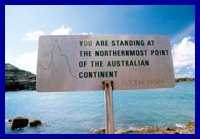
The distance from Cairns to the tip of Australia is about 1,000 km where the
finger of Cape York points to New Guinea
which lies beyond the islands of the Torres Straits. After departing
Seisia the ship commences its southern voyage along the same path back to Cairns.
Click here for
a detailed map of Cape York.
[P.P.S. There just won't be enough time to rediscover T.I. in the few hours the
MV Trinity Bay will be in port. I have therefore decided to break my journey and
spend a whole week on the island before boarding the same boat again when it returns
on its next weekly run.]
|
 & Rover
& Rover
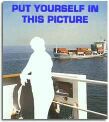
 P.S. Booking this trip aboard the "Trinity Bay" has re-awakened my taste for
the sea which in years past I have only been able to assuage by reading lots of
Joseph Conrad. But there is a better way: freighter travel!
It's a great way of travelling the world at a leisurely pace
and at a fraction of the cost of the usual ocean travel.
I have made contact with
OLDENDORFF Carriers and shall be on the look-out
for one of their vessels sailing from Australia or New Zealand in the second half
of this year.
P.S. Booking this trip aboard the "Trinity Bay" has re-awakened my taste for
the sea which in years past I have only been able to assuage by reading lots of
Joseph Conrad. But there is a better way: freighter travel!
It's a great way of travelling the world at a leisurely pace
and at a fraction of the cost of the usual ocean travel.
I have made contact with
OLDENDORFF Carriers and shall be on the look-out
for one of their vessels sailing from Australia or New Zealand in the second half
of this year.
 Padma flies on
Padma flies on 
 [P.S. I have since been able to make email contact with a very nice lady by the name of Nola
who works for the Council on TI. She knows the people I have known and
tells me that the Fulwoods now live in Mackay and Roly in Cairns, "Canadian Jim" is now in his
80s and lives on Horn Island ("Canadian Jim" liked his drink and it wasn't
"Canada Dry" and I am surprised his liver held out this long -
his "shadow" Ron Taylor retired from IIB in 2001 and moved to Cairns where
passed away in 2003),
and Brian Pearson (who "inherited" my dog Snoopy when I left the island) and his wife Sara still live on TI where
he drives a taxi. Brian, you've got yourself a fare for Sunday the 24th of April!
- maybe even longer as I am seriously considering staying over on the island
and taking the same boat back when it returns a week later. Nola also mentioned that
David Richardson's shack at Country Women's Beach on Prince-of-Wales Island was bought
by her brother many years ago, that the huge cyclone-proof shed which Yvonne, the hairdresser,
and her husband built at Bluefish Point was later moved to the main beach now called
Muralug and that somebody else, "Maori George", now lives in it,
[P.S. I have since been able to make email contact with a very nice lady by the name of Nola
who works for the Council on TI. She knows the people I have known and
tells me that the Fulwoods now live in Mackay and Roly in Cairns, "Canadian Jim" is now in his
80s and lives on Horn Island ("Canadian Jim" liked his drink and it wasn't
"Canada Dry" and I am surprised his liver held out this long -
his "shadow" Ron Taylor retired from IIB in 2001 and moved to Cairns where
passed away in 2003),
and Brian Pearson (who "inherited" my dog Snoopy when I left the island) and his wife Sara still live on TI where
he drives a taxi. Brian, you've got yourself a fare for Sunday the 24th of April!
- maybe even longer as I am seriously considering staying over on the island
and taking the same boat back when it returns a week later. Nola also mentioned that
David Richardson's shack at Country Women's Beach on Prince-of-Wales Island was bought
by her brother many years ago, that the huge cyclone-proof shed which Yvonne, the hairdresser,
and her husband built at Bluefish Point was later moved to the main beach now called
Muralug and that somebody else, "Maori George", now lives in it,


 When I lived and worked on the island,
the Grand's dining room had been crammed with souvenirs
When I lived and worked on the island,
the Grand's dining room had been crammed with souvenirs
 of the Torres Strait's maritime history,
but early on the 5th of March, 1993
all was destroyed in a blaze which began about 4am and
swept through the timber building in less than an hour, forcing the evacuation of 12 people
and causing about $2 million damage. No one was injured but together with the then licensee,
Mr Norm Shadbolt, the whole island mourned the enormous loss of history.
of the Torres Strait's maritime history,
but early on the 5th of March, 1993
all was destroyed in a blaze which began about 4am and
swept through the timber building in less than an hour, forcing the evacuation of 12 people
and causing about $2 million damage. No one was injured but together with the then licensee,
Mr Norm Shadbolt, the whole island mourned the enormous loss of history.

 After leaving Cairns it’s not long until the ship reaches
After leaving Cairns it’s not long until the ship reaches
 Early Saturday morning the ship arrives at Cape Melville, the southern point of
Princess Charlotte Bay and the site of one of
Queenslands worst maritime disasters, when on the 4th and 5th March 1899 a
cyclone passed over the area. It destroyed
the pearling fleet with the loss of 307 lives, 5 large vessels and 54 luggers.
The cyclone was named Mahina, had a
central pressure of 914mb and produced a storm surge of over 40 feet.
Cape Melville is part of the Melville National
park famous for its foxtail palms which were unique to the area and
much sought after by horticulturists. This demand
encouraged poachers who, each year when the palms seeded, mounted a
harvesting program which produced an equal
effort by the park rangers to apprehend the poachers. The poachers must
have been successful as these palms can now
be purchased in most nurseries.
Early Saturday morning the ship arrives at Cape Melville, the southern point of
Princess Charlotte Bay and the site of one of
Queenslands worst maritime disasters, when on the 4th and 5th March 1899 a
cyclone passed over the area. It destroyed
the pearling fleet with the loss of 307 lives, 5 large vessels and 54 luggers.
The cyclone was named Mahina, had a
central pressure of 914mb and produced a storm surge of over 40 feet.
Cape Melville is part of the Melville National
park famous for its foxtail palms which were unique to the area and
much sought after by horticulturists. This demand
encouraged poachers who, each year when the palms seeded, mounted a
harvesting program which produced an equal
effort by the park rangers to apprehend the poachers. The poachers must
have been successful as these palms can now
be purchased in most nurseries.
 Pipon Island is the point where the vessel deviates from the regular shipping
channel and transits the Fairway Channel
taking it between the Inner and Outer reef. At times the large ocean swells can be
seen breaking on the outer reef.
Not long after departing Pipon Island, the Flinders group of islands can be
seen on the portside of the vessel. These
islands are sacred areas to the local Aborigines and also posses some very
impressive galleries of rock paintings.
Pipon Island is the point where the vessel deviates from the regular shipping
channel and transits the Fairway Channel
taking it between the Inner and Outer reef. At times the large ocean swells can be
seen breaking on the outer reef.
Not long after departing Pipon Island, the Flinders group of islands can be
seen on the portside of the vessel. These
islands are sacred areas to the local Aborigines and also posses some very
impressive galleries of rock paintings.
 As the vessel travels through an outer passage north of the Flinders group,
numerous sand cays and reef outcrops become
visible in close proximity. During the fishing season, a number of trawlers
can also be seen in these grounds.
As the vessel travels through an outer passage north of the Flinders group,
numerous sand cays and reef outcrops become
visible in close proximity. During the fishing season, a number of trawlers
can also be seen in these grounds.
 On Saturday afternoon the "Trinity Bay" arrives at Lockhart River, the
first stop on the northern voyage. Here it meets another Sea
Swift vessel the "Temple Bay" to which it tranships cargo destined for the
Lockhart River community. The "Temple Bay" is a 23 metre
landing barge which is used to carry the cargo to shore as there is only a
barge ramp in this area and the surrounding shallow
area prohibits access to the "Trinity Bay".
On Saturday afternoon the "Trinity Bay" arrives at Lockhart River, the
first stop on the northern voyage. Here it meets another Sea
Swift vessel the "Temple Bay" to which it tranships cargo destined for the
Lockhart River community. The "Temple Bay" is a 23 metre
landing barge which is used to carry the cargo to shore as there is only a
barge ramp in this area and the surrounding shallow
area prohibits access to the "Trinity Bay".
 After leaving the anchorage at Lloyd Bay the ship passes Restoration Island,
which is significant as the first landfall of Captain
William Bligh after he and his companions were forced into the long boat during
the mutiny of the “Bounty” near Tahiti.
A few miles further on is Portland Roads which until the 1980's used to have a
large timber wharf used by the allies during
World War 2 as a jump off point for the New Guinea campaign. The wharf was more
recently blown up by the Navy
because of its dilapidated condition. Portland Roads is a safe anchorage used by
the fishing fleet and the motherships
which supply them with fuel, water and stores, and unload their catch which is
returned to Cairns for export.
The community ashore attracts people who tend to follow an alternative lifestyle,
avoiding the pressures of city dwellers.
Three hours further north the ship passes Cape Grenville and the Home Island group,
most of which were named by Captain
Cook after members of the “Endeavour” crew. Occasionally the "Trinity Bay"
stops at this location to deliver cargo to a couple of the
small resort islands.
After leaving the anchorage at Lloyd Bay the ship passes Restoration Island,
which is significant as the first landfall of Captain
William Bligh after he and his companions were forced into the long boat during
the mutiny of the “Bounty” near Tahiti.
A few miles further on is Portland Roads which until the 1980's used to have a
large timber wharf used by the allies during
World War 2 as a jump off point for the New Guinea campaign. The wharf was more
recently blown up by the Navy
because of its dilapidated condition. Portland Roads is a safe anchorage used by
the fishing fleet and the motherships
which supply them with fuel, water and stores, and unload their catch which is
returned to Cairns for export.
The community ashore attracts people who tend to follow an alternative lifestyle,
avoiding the pressures of city dwellers.
Three hours further north the ship passes Cape Grenville and the Home Island group,
most of which were named by Captain
Cook after members of the “Endeavour” crew. Occasionally the "Trinity Bay"
stops at this location to deliver cargo to a couple of the
small resort islands.
 As always there are small islands and reefs that the ship passes on its way north.
Some of these islands and sand cays
are popular turtle breeding grounds for turtles from all around the world.
Every summer they converge here to lay
eggs and breed. Each year in December we transport officers from the
Department of Environment and Heritage to
Milman Island to carry out research and gather information about the turtles,
which goes towards a better understanding
of their habits and needs and in turn helps to protect the species.
As always there are small islands and reefs that the ship passes on its way north.
Some of these islands and sand cays
are popular turtle breeding grounds for turtles from all around the world.
Every summer they converge here to lay
eggs and breed. Each year in December we transport officers from the
Department of Environment and Heritage to
Milman Island to carry out research and gather information about the turtles,
which goes towards a better understanding
of their habits and needs and in turn helps to protect the species.
 Early Sunday morning finds the ship close to Cape York and Albany Island.
In the Albany Passage (an optional route
sometimes taken by the ship) is one of the many pearl farms in the Torres
Strait area and also the remains of the
ill-fated community of Somerset, the once mooted "Singapore of the Pacific", and the
Early Sunday morning finds the ship close to Cape York and Albany Island.
In the Albany Passage (an optional route
sometimes taken by the ship) is one of the many pearl farms in the Torres
Strait area and also the remains of the
ill-fated community of Somerset, the once mooted "Singapore of the Pacific", and the
 Sunday morning is spent at
Sunday morning is spent at
 Finally, on Sunday afternoon the "Trinity Bay " arrives at
Finally, on Sunday afternoon the "Trinity Bay " arrives at
 Arrangements can be made for a personalised and informative bus tour of the Island
by a local guide who will show
you why TI is one of the most culturally and historically interesting places in Australia.
The tour takes in spectacular
views and visits the Torres Strait Museum (not always accessible on Sundays),
Green Hill Fort (circa 1891), Quetta
Memorial Cathedral and the Japanese Pearl Divers Memorial at the local cemetery.
Arrangements can be made for a personalised and informative bus tour of the Island
by a local guide who will show
you why TI is one of the most culturally and historically interesting places in Australia.
The tour takes in spectacular
views and visits the Torres Strait Museum (not always accessible on Sundays),
Green Hill Fort (circa 1891), Quetta
Memorial Cathedral and the Japanese Pearl Divers Memorial at the local cemetery.
 Seisia is the coastal link to the larger community of Bamaga, which is the most
northerly destination for four-wheel
drivers heading up the Cape. Bamaga is the largest of the five communities
located on the far northerly point of the Cape
– the others being Seisia, Umagico, Inginoo and New Mapoon. Fishing safaries,
accommodation, motoring assistance,
fuel and groceries can be purchased in Bamaga.
Seisia Campground also offer accommodation and tours. Passengers on the "Trinity Bay"
are invited to make the 4WD
journey to the very ‘tip’ of the Cape – a half day journey whilst the vessel is in port.
Seisia is the coastal link to the larger community of Bamaga, which is the most
northerly destination for four-wheel
drivers heading up the Cape. Bamaga is the largest of the five communities
located on the far northerly point of the Cape
– the others being Seisia, Umagico, Inginoo and New Mapoon. Fishing safaries,
accommodation, motoring assistance,
fuel and groceries can be purchased in Bamaga.
Seisia Campground also offer accommodation and tours. Passengers on the "Trinity Bay"
are invited to make the 4WD
journey to the very ‘tip’ of the Cape – a half day journey whilst the vessel is in port.
